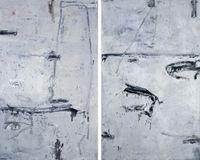Huang Rui's artworks often deal with critical and political subject matter, presented using a number of mediums including photography, installation, printmaking, performance, and—most frequently—painting.
Read MoreForced into the countryside of Inner Mongolia for 're-education' as a teenager, where he laboured through the Cultural Revolution, Huang's practice expanded greatly after 1976, following a pivotal moment in both politics and art in China. Soon after Mao Zedong's death and the subsequent end of the revolution in 1976, the artist and his contemporaries took advantage of a period of fervent, tentative freedom and access to the world's art and culture. Joined by a group of young intellectuals and artists, Huang began to work in expressly Western and Modernist mediums, in direct opposition to the state-sanctioned methods of Socialist Realism. Over the years, the artist has garnered inspiration from key movements in Western art history and the aesthetics of traditional Chinese ink to develop a style that is a confluence of technique and thought.
Part of a generation of Chinese artists who pioneered contemporary art in the country, Huang also co-founded a literary magazine, Jintian (Today), in 1979 with poets Bei Dao and Mang Ke. Together with Wang Keping, Ma Desheng, and others, he also formed the Stars artist group (1979–1984), whose seminal, striking exhibition outside what is now known as the National Art Museum of China in Beijing in 1979 would be a turning point in protest art history in China. The exhibition presented works by 23 artists hung on the railings outside of the Museum. It was forcibly removed by the authorities just two days after its opening. The Stars group was also crucial to the development of the Chinese avantgarde approach of the mid-1980s on. Around this time, when his contemporaries began to leave China in pursuit of their artistic careers, Huang moved to Osaka, where he remained until 2001.
During this early period in his practice, Huang created works inspired heavily by Fauvism and Cubism, coupled with notions of Japanese Zen practice. One of his most iconic pieces, April 5, 1976 (1978) depicts a half-naked female figure draped across a scene of faces taken from protests of the Tiananmen Incident of 1976. The figure is a convergence of aesthetics seen in iconic Western art, including Eugène Delacroix's Liberty Leading the People (1830) and statues of the Venus de Milo. In the early 1980s, Huang created a series of paintings after Piet Mondrian, exploring fields of saturated colour, abstraction, and the minimalism of architectural form, as seen in Courtyard Abstraction No. 2 (1983). He also began working with Chinese ink, creating visceral pieces using fast, heavy, calligraphic brushwork that revealed abstract scenes. An example of this is Black and White Chinese Landscape Painting (1987).
After returning to Beijing in 2002, Huang started combining his interests in various mediums and aesthetics into conceptual works that continued to be imbued with contemporary politics at a time when China was experiencing rapid change in its economy and foreign policy. He began using Songti—the Chinese typeface developed and regularised during the Song Dynasty—in his artwork, which harkened back to Communist propaganda posters. During this time he also experimented with juxtapositions of different colour palettes against one another to emphasise the ambiguous nature of language and how re-contextualisation can be impactful even with the subtlest shift in perspective. His 'Chai-na/China' series (2004–2009) was clear in its criticism of the government's constant destruction and reconstruction of the country ('chai na' in Chinese means 'demolish there'), particularly in the lead-up to the 2008 Beijing Olympics. With many artists facing increasing persecution and censorship in China, Huang's own studio situated in the northeast of Beijing seems under constant threat of demolition, particularly since 2016 following the end of a 10-year lease. The studio design is Bauhaus-inspired, surrounded by walls constructed using the Qing- and Ming-dynasty bricks of old buildings from neighbourhoods that had been razed, echoing the artist's interwoven practice.
Huang continues to create art that is reflective of contemporary Chinese society and thought. In the later 2010s he returned to his original style of painting, creating works such as in the series 'Zen Space' (2018), which he described as 'a continuous experimentation towards the most essential statement of art'. Shown alongside his works from the 1980s in one North American retrospective of his work, viewers witnessed a narrative of the artist's career having come full circle.
Apoorva Rajagopal | Ocula | 2019




